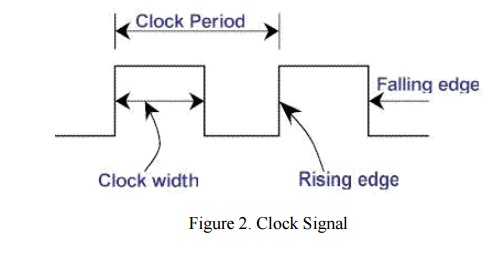Sequential circuits are divided into two main types: synchronous and asynchronous. Their classification depends on the timing of their signals.
Synchronous sequential circuits change their states and output values at discrete instants of time, which are specified by the rising and falling edge of a free-running clock signal. The clock signal is generally some form of square wave as shown in Figure 2 below.

From the diagram you can see that the clock period is the time between successive transitions in the same direction, that is, between two rising or two falling edges. State transitions in synchronous sequential circuits are made to take place at times when the clock is making a transition from 0 to 1 (rising edge) or from 1 to 0 (falling edge). Between successive clock pulses there is no change in the information stored in memory.
The reciprocal of the clock period is referred to as the clock frequency. The clock width is defined as the time during which the value of the clock signal is equal to 1. The ratio of the clock width and clock period is referred to as the duty cycle. A clock signal is said to be active high if the state changes occur at the clock's rising edge or during the clock width. Otherwise, the clock is said to be active low. Synchronous sequential circuits are also known as clocked sequential circuits.
The memory elements used in synchronous sequential circuits are usually flip-flops. These circuits are binary cells capable of storing one bit of information. A flip-flop circuit has two outputs, one for the normal value and one for the complement value of the bit stored in it.
Binary information can enter a flip-flop in a variety of ways, a fact which give rise to the different types of flip-flops. For information on the different types of basic flip-flop circuits and their logical properties, see the previous tutorial on flip-flops.
In asynchronous sequential circuits, the transition from one state to another is initiated by the change in the primary inputs; there is no external synchronisation. The memory commonly used in asynchronous sequential circuits are time-delayed devices, usually implemented by feedback among logic gates. Thus, asynchronous sequential circuits may be regarded as combinational circuits with feedback. Because of the feedback among logic gates, asynchronous sequential circuits may, at times, become unstable due to transient conditions. The instability problem imposes many difficulties on the designer. Hence, they are not as commonly used as synchronous systems.

